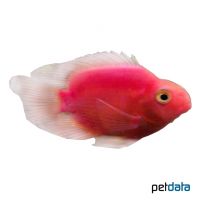Red Parrot Cichlid (Cichlidae sp. 'Red Parrot')
| Red Parrot Cichlid Cichlidae sp. 'Red Parrot' | |
|---|---|
| Name | Red Parrot Cichlid |
| Name Lat. | Cichlidae sp. 'Red Parrot' |
| Family | Cichlids |
| Family lat. | Cichlidae |
| Order | Cichlids |
| Order lat. | Cichliformes |
| Origin | Hybrid breeding |
| Habitat | Aquarium |
| Diet | Carnivore |
| pH | 6.5-7.5 |
| Behavior | Semi-aggressive |
| Keeping | Pair, group |
| Care Level | Easy |
| Reproduction | Substrate spawner |
| Breeding | Simple |
| Life Span | 10-15 years |
| Protection | No |
| Metric Units | |
| Size | 20 cm |
| Temperature | 24-28 °C |
| Hardness | 4-10 °dH |
| Aquarium | ~ 250 l |
| US Units | |
| Size | 8" |
| Temperature | 75-82 °F |
| Hardness | 71-178 ppm |
| Aquarium | ~ 65 gal |
Distribution and habitat
The Red Parrot Cichlid is a hybrid breed. It is said to be a hybrid of various Central American cichlids and they are primarily bred in Asia. They owe their name Parrot Cichlid to their beak-like shaped mouth.
Maintenance
The aquarium should have a robust border planting, with many hiding places (stones, roots), and offer free swimming space. A substrate of sand or fine gravel covered with some foliage (e.g. sea almond leaves) and slightly subdued light (floating plants) is ideal.
No ammonia, ammonium and nitrite should be detectable, the nitrate value should not exceed 100 mg/l. To ensure the water quality and oxygen content, a filter and heater adapted to the aquarium size is required, as well as lighting for the species-appropriate day-night rhythm of the animals.
Diet
The food offer consists of high-quality sinking dry food for cichlids (pellets, granules, chips), supplemented with live or frozen Artemia, Mysis, Red Mosquito Larvae or a frozen special food mixture enriched with vitamins for large cichlids
It is recommended to feed them small portions several times a day, as they are slow eaters with their beak-like mouths. Only feed as much as will be eaten within a few minutes. A regular and varied diet promotes health and increases resistance.
Behaviour and compatibility
It is recommended to keep them in pairs or in a group. They are mostly peaceful within the species and towards other fish and can be socialized well with not too small, peaceful fish. Only at spawning time they behave somewhat territorial.
Basically, only compatible fish species with similar demands on water quality and water temperature should be socialized.
Sex dimorphism
There are no known external distinguishing characteristics.
Reproduction and breeding
The males of this hybrid breed are sterile, therefore breeding with a purebred pair is not possible. Successful further breeding is only possible by backcrossing with one of the parentage animals. However, parrot cichlid females can be successfully crossed with some cichlid males from the Cichlasomatinae group.
They spawn on shallow rocks or roots (open brooders). Both parents perform brood care and defend the territory (parental family). After about 2 days, the fry hatch and are then usually housed in a bottom pit until they swim freely after 5-7 days. Often the fry are still guarded by the parents for some time and are led to the feeding places in the aquarium.
Fry must be fed several times a day with special rearing food (Artemia). In community tanks breeding is hardly possible, because the fry are easy prey.
Important
Parrot cichlids are bred in several color varieties.
They like to burrow, often damaging plants, so it is recommended to use potted plants.
The well-being of the fish should be checked regularly. Temperature should be checked daily, pH, hardness and nitrate levels at least every 14 days. Regular partial water changes are recommended, even if the pollutant level has not yet reached the upper limit. Sudden changes in water quality should be avoided. Newly introduced fish must be accustomed slowly to the water in the aquarium.
Further literature can be found in your pet store.
References
Text: Werner Winter; Image: petdata
Source: BMEL (1998): Tierschutzgutachten - Haltung von Zierfischen (Süßwasser); RIEHL & BAENSCH (2006): Aquarien Atlas Bd. 1, Mergus Verlag; ENGELMANN (2005): Zootierhaltung - Tiere in menschlicher Obhut: Fische, Verlag Harri Deutsch
- Gemäß § 21 Abs. 5 Tierschutzgesetz idgF
